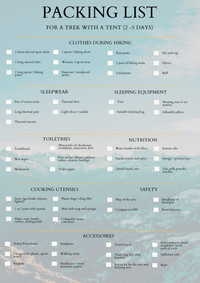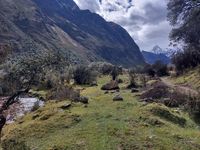Trekking Stories
For and by hikers
The ultimate packing list for a succesful tent trek!
Whether you're an experienced camper or embarking on your first multi-day tent trek, thorough preparation is essential for a successful outdoor adventure. A well-thought-out packing list can make the difference between comfortably enjoying nature and struggling with missing items or inadequate gear. In this blog post, we share a comprehensive packing list to ensure you don't forget anything important and can fully enjoy your tent trek.
Tent and sleeping gear:
- A tent provides shelter and privacy during your nights in nature. Ensure you choose a tent suitable for the number of people on the trip and the expected weather conditions.
- A good sleeping bag is essential for staying warm during cold nights. When choosing a sleeping bag, consider the comfort temperature and insulation rating.
- A sleeping pad or air mattress provides insulation between you and the cold ground, enhancing sleep comfort.
- A pillow or inflatable pillow can make a difference for a good night's sleep, but you can also fold clothes to create a pillow as an alternative.
- A repair kit for a tent and sleeping pad can come in handy for minor repairs along the way to keep your gear in good condition.
Clothing:
- The right type of clothing can protect you from weather conditions and keep you comfortable during your trek. Ensure you have layers that you can adjust to changing temperatures.
- Waterproof and breathable clothing is essential to stay dry and comfortable in rainy weather.
- Thermal underwear helps you stay warm in cold conditions by wicking moisture away from your body.
- High-quality hiking socks reduce the risk of blisters and provide comfort during long walks.
- Footwear:
- Sturdy hiking boots provide the support and traction you need while walking on rugged terrain.
- Sandals or lightweight shoes are handy for around the camp or during breaks.
Kitchen and cooking equipment:
- A portable stove allows you to prepare meals, make hot drinks, and boil water for consumption.
- Pans and/or pots are necessary for cooking food and boiling water.
- Plates, bowls, cups, and utensils make eating and drinking during your trek easier and more comfortable.
- Dishwashing liquid and a sponge are essential for cleaning kitchenware and maintaining hygiene.
Food:
- Choose nutritious and energy-rich options that take up little space and are lightweight, such as dried fruit, nuts, grains, and energy bars. Get inspiration for snacks here.
- Don't forget to bring enough water and/or water purification tablets to stay hydrated during your journey.
Navigation and lighting:
- Maps, a compass, or GPS device help you find your way and stay on course during your trek.
- A headlamp or flashlight is essential for lighting during camping and nighttime activities.
Personal care:
- Personal hygiene is important, even during a trek. Make sure to bring the necessary toiletries and towels.
- During the day while hiking, you often sweat, and when it dries, you can cool down quickly. Remove dried sweat with moist wipes so you feel much fresher and don't cool down quickly.
- Protect yourself from the sun and insect bites with sunscreen, lip balm, and insect repellent.
- A first aid kit provides the necessary bandages and medication for emergencies on the way.
Other equipment:
- A sturdy backpack is essential for carrying all your equipment during your journey.

